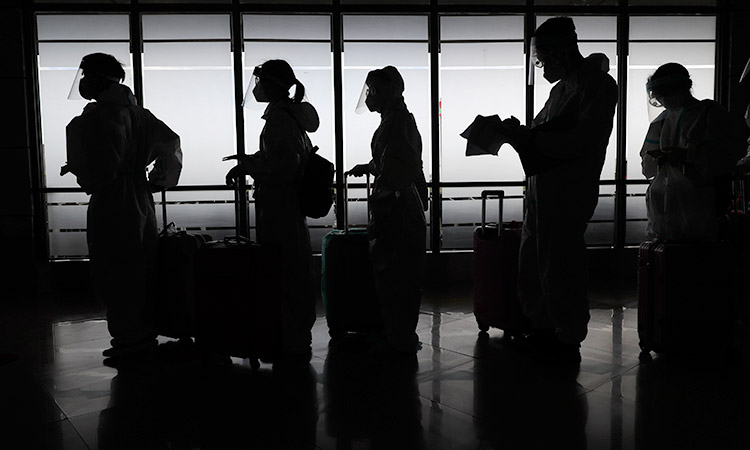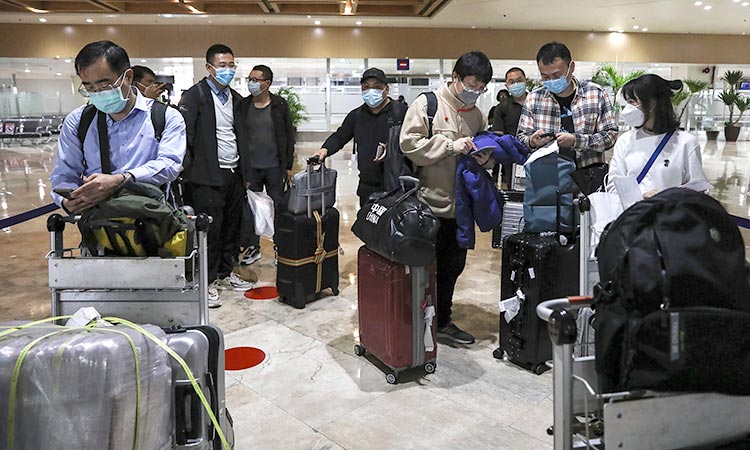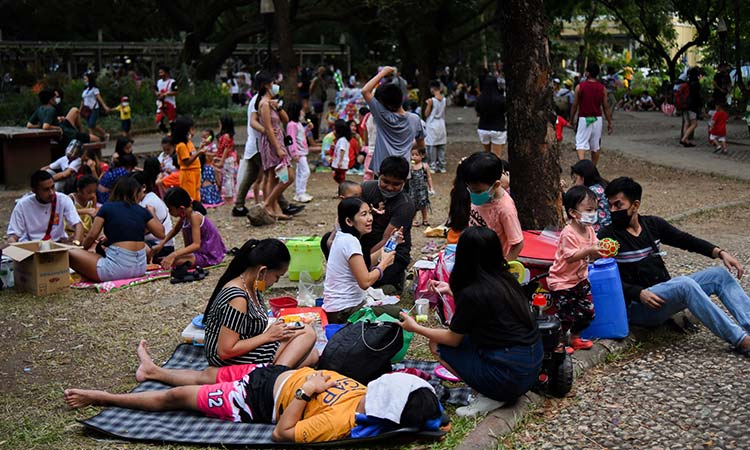Philippines welcomes tourists from 157 countries after 2 years, lays down fresh conditions

Philippine Coast Guard members assist passengers as they arrive at Manila's International Airport. AP
Mariecar Jara-Puyod, Senior Reporter
Foreigners who plan to holiday in the Philippines must secure themselves with at least $35,000.00 (Dhs128,555.00/Php1,793,627.50) travel health insurance to cover possible treatment against the Novel Coronavirus (COVID-19).
The requirement is among four, as the Philippines’ Inter-Agency Task Force for the Management of Emerging Infectious Diseases (IATF-EID) had decided the nation is ready to welcome, after almost two years of lockdown, fully-vaccinated leisure visitors, including their unvaccinated children below age 12, from 157 visa-free countries, beginning Feb. 10.
READ MORE
UAE to lift COVID-related restrictions by mid-February
Global COVID-19 case counts decline 17 per cent in latest week
From Manila’s Department of Foreign Affairs website, among the 157 nationalities who can enter the Philippines, either for business and/or tourism purposes for a maximum of 30 days are the Emiratis, Bahrainis, Kuwaitis, Saudis, Qataris, and Omanis, EU citizens and Southeast Asians. Brazilians and Israelis can stay for a maximum of 59 days, Hong Kong and Macao Special Administration Region passport holders for a maximum of 14 days, and Macao-Portuguese as well as Hong Kong-British passport holders, for a maximum of seven days.
Foreign passengers prepare for their flight to China at Manila's International Airport, Philippines. AP
As per the IATF-EID parameters, fully vaccinated COVID-19 tourists are the twice inoculated in a two-dose series or a single dose vaccine more than two weeks before the date and time of departure from the country of origin.
These foreign tourists shall not undergo facility-based quarantine. But, according to Philippine Tourism Secretary Bernadette Romulo-Puyat, must self-monitor and report to the nearest local government unit (LGU), should they manifest COVID19-related signs and symptoms.
In the case of unvaccinated children below 12 years old whose citizenship is different from their Filipino parent/s, they shall be allowed entry and shall be required to follow the entry, testing, and quarantine protocols that apply to their Filipino parent/s. Those between the ages of 12 and 17 must adhere to the safety measures based on their vaccination status, and shall be accompanied by their parents during their facility-based quarantine.
Foreign passengers wearing protective masks arrive at Manila's International Airport, Philippines. AP
Gulf Today received the list of requirements on Tuesday evening. Puyat issued a reminder to foreign visitors with regard to these last Friday to ensure seamless travel experience.
Based on the IATF-EID Resolution 160-B, the other requirements are:
• Acceptable proof of complete COVID-19 vaccination recognised by the IATF-EID that include certificates of vaccination issued by the World Health Organisation, the VAXCertPH of the Department of Health available over https://vaxcert.doh.gov.ph, and a national/state digital certificate of a foreign government which has accepted the VAXCertPH under a reciprocal arrangement unless otherwise permitted by the IATF-EID.
• Negative RT-PCR test taken within 48 hours before the date and time of departure from the country of origin/first port of embarkation in a continuous travel to the Philippines, excluding layovers for their return journey.
• Valid tickets for their return journey to the port of origin or next port of destination not later than 30 days from the date of arrival in the Philippines.
• Passports with at least six months validity at the time of arrival in the Philippines.
On the travel health insurance, Puyat pointed out that this must be secured from “reputable insurers” and that the premium is good for the duration of their stay in the Philippines.
“With years of coordination between national agencies, industry stakeholders, and the various (LGUs) to prepare our destinations for tourism in the new normal, we are confident that we will be able to keep pace with our (Association of Southeast Asian Nations-ASEAN) neighbours who have already made similar strides to reopen to foreign nationals,” Puyat said.
In January and from Dubai, visiting Tourism Authority of Thailand senior officials announced the inclusion of travel health insurance in the re-opening of the Southeast Asian kingdom to foreign tourists.
From the Sept. 29, 2021 “New Normal Travel Insurance: ASEAN in the Post-COVID-19 Era” of the Milliman.com: “In Thailand, all general insurers are providing COVID-19 medical expenses coverage as part of their travel products at the requirement of regulators. Several insurers in Singapore, Malaysia and the Philippines have added comprehensive COVID-19 coverage, though add-ons are not limited to medical expenses, daily cash benefits upon quarantine, repatriation and trip cancellations.”
Puyat said: “The new guidelines issued by the IATF-EID are an indication that, while the country has opened its borders to fully vaccinated business and leisure visitors, it is doing so with utmost care and with regard for the health and safety of both visitors and the general public.”
The re-opening of the Philippines as a global tourism destination was put on hold by mid-December last year when its Department of Health had confirmed that a returning overseas Filipino worker from Japan and a visitor from Nigeria, first week of the month, had tested positive of the Omnicron variant. Omnicron cases had risen since then and which only tapered in the last several days.









